Tres Pistolas Trail Headin Tijeras Canyon, New Mexico-- a birder's album |

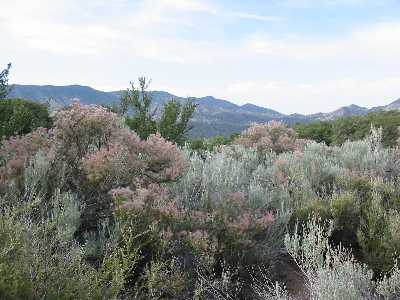
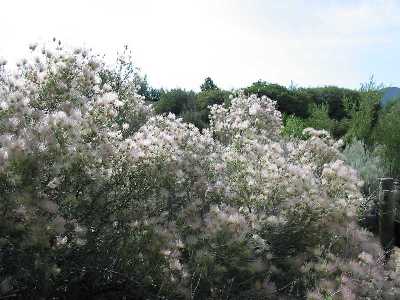
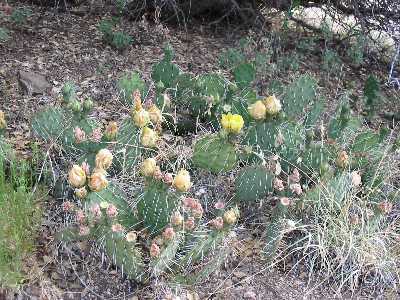
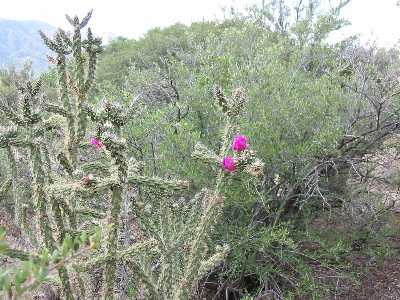 CLICK ON THE FOLLOWING
IMAGES FOR LARGER VIEWS. All photos were taken on
location with Canon A40-- where
necessary, through Kowa 77 mm spotting scope. The picture to the
left was taken just a few feet from the parking area. It
shows a rich mixture of shrubs: Rabbitbrush, Apache Plume, Cholla,
Prickly Pear, Mountain Mahogany, and shrubby Gray Oak with smooth,
gray-green leaves and Shrub or Desert Live Oak, which has prickly,
holly-like leaves, gray-green to green
in color.. To the right
are pictured Cholla , Desert Prickly Pear, and
Apache Plume, all in bloom.
This patch often harbors wintering Fox and White-crowned
Sparrows, and family groups of Scaled Quail.
CLICK ON THE FOLLOWING
IMAGES FOR LARGER VIEWS. All photos were taken on
location with Canon A40-- where
necessary, through Kowa 77 mm spotting scope. The picture to the
left was taken just a few feet from the parking area. It
shows a rich mixture of shrubs: Rabbitbrush, Apache Plume, Cholla,
Prickly Pear, Mountain Mahogany, and shrubby Gray Oak with smooth,
gray-green leaves and Shrub or Desert Live Oak, which has prickly,
holly-like leaves, gray-green to green
in color.. To the right
are pictured Cholla , Desert Prickly Pear, and
Apache Plume, all in bloom.
This patch often harbors wintering Fox and White-crowned
Sparrows, and family groups of Scaled Quail.
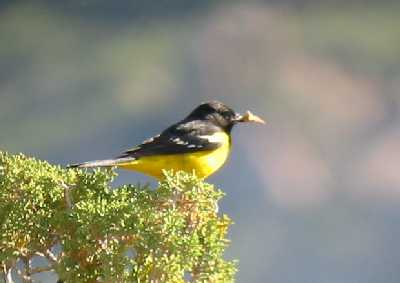
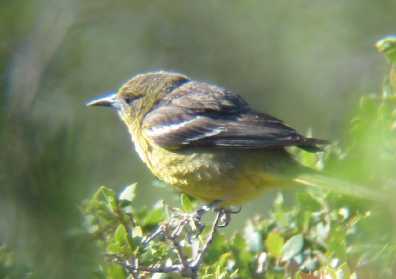
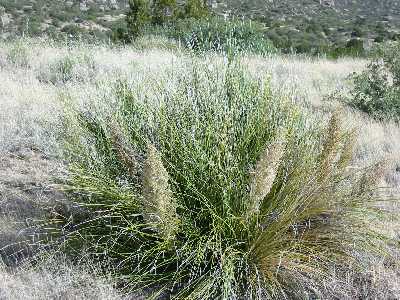
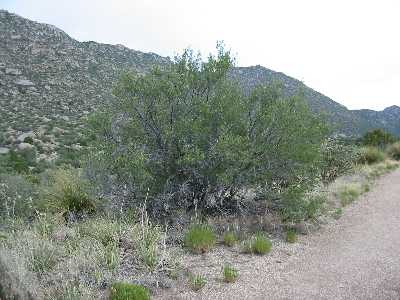 Early in the spring, often by
mid-April, Scott's Oriole
(male, carrying an insect to nestlings, and
female, pictured to the left) arrive to begin the chores of
defending a territory and pairing up. The melodic song is
reminiscent of snippets from
the Western Meadowlark's carol. By mid-May, nest building is
underway,
and June finds the couple gathering food for the young. Unlike
the
familiar Bullock's and many other orioles, Scotts Oriole may weave its
nest rather close to the ground, in Juniper, Mountain Mahogany (to
the near
right), a yucca, or even a clump of Mistletoe. Beargrass (pictured
on
the far right) and Desert Prickly Pear are present through the
desert grassland/juniper-oak savannah at the lower parts of the area,
good habitat for
Scott's Oriole.
Early in the spring, often by
mid-April, Scott's Oriole
(male, carrying an insect to nestlings, and
female, pictured to the left) arrive to begin the chores of
defending a territory and pairing up. The melodic song is
reminiscent of snippets from
the Western Meadowlark's carol. By mid-May, nest building is
underway,
and June finds the couple gathering food for the young. Unlike
the
familiar Bullock's and many other orioles, Scotts Oriole may weave its
nest rather close to the ground, in Juniper, Mountain Mahogany (to
the near
right), a yucca, or even a clump of Mistletoe. Beargrass (pictured
on
the far right) and Desert Prickly Pear are present through the
desert grassland/juniper-oak savannah at the lower parts of the area,
good habitat for
Scott's Oriole.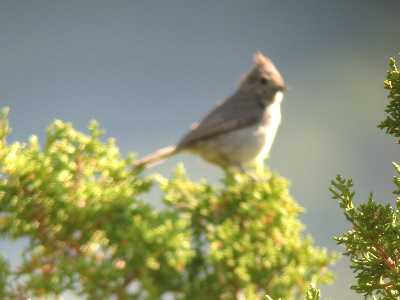
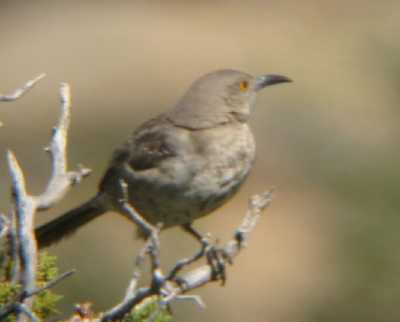
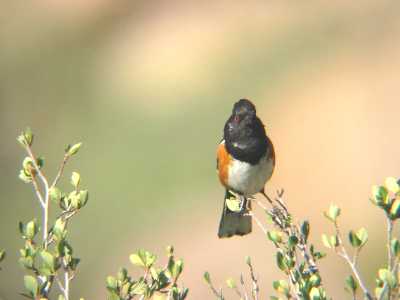 Typical birds of the pygmy
oak-piñon-juniper
woodland include Spotted Towhee,
Curve-billed Thrasher, Juniper
Titmouse (pictured to the right), Northern Mockingbird, and
Black-chinned Hummingbird (left). Other breeding birds
include the Crissal Thrasher,
Broad-tailed Hummingbird, Bushtit,
Ash-throated Flycatcher, Black-headed Grosbeak, Bullock's Oriole,
Canyon
Towhee, Rufous-crowned Sparrow, Red-tailed Hawk, Kestrel
and
Golden
Eagle. Other migrants include the host of hawks counted
every
spring
at the Sandia Hawk Watch viewing and banding site. With luck we
will
add photos of these birds to this album, and
Typical birds of the pygmy
oak-piñon-juniper
woodland include Spotted Towhee,
Curve-billed Thrasher, Juniper
Titmouse (pictured to the right), Northern Mockingbird, and
Black-chinned Hummingbird (left). Other breeding birds
include the Crissal Thrasher,
Broad-tailed Hummingbird, Bushtit,
Ash-throated Flycatcher, Black-headed Grosbeak, Bullock's Oriole,
Canyon
Towhee, Rufous-crowned Sparrow, Red-tailed Hawk, Kestrel
and
Golden
Eagle. Other migrants include the host of hawks counted
every
spring
at the Sandia Hawk Watch viewing and banding site. With luck we
will
add photos of these birds to this album, and 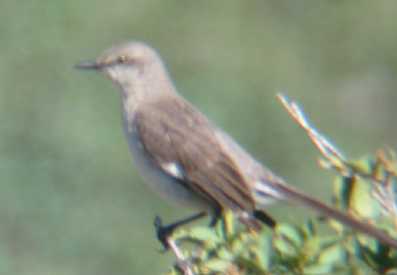
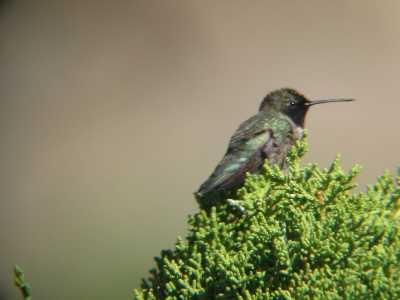 replace
some of the fuzzy images with better takes.
replace
some of the fuzzy images with better takes. HOW
TO GET THERE: Tres Pistolas
is located north of I-40 in Tijeras Canyon, just east of Albuquerque,
north of the Monticello Subdivision. From Albuquerque, take I-40
east to exit 170 (Carnuel). Take NM-333 (Historic Route 66) to
the
left (east) about 1.8 miles to Monticello. The left (north) turn
into Monticello is marked by a very small green sign in the median,
over
an orange construction barrel. If you pass the Taxidermy building
on NM 333 you have gone too far east. From
Tijeras, go west on old 66 approximately one mile past Deadman's
Curve (which is where the road passes under I-40). Turn right on
Monticello Rd. There is a green street sign in
the center median indicating Monticello. You will have to make a 180
degree turn to get on Monticello, then follow around the curve and come
up the hill. Take
Monticello north to the first
left turn, which is Siempre Verde. Follow Siempre Verde as it
curves to the north, all the way to the top. At Alegre bear
slightly left, where Siempre Verde becomes a dirt road that becomes
Tres Pistolas road and leads to the parking lot at the trail head.
Be sure to bird the Monticello subdivision all the way up to Tres
Pistolas. Curve-billed Thrashers are common in the ornamental
cactus. Scott's Oriole is usually fairly
easy to find along the stretch of dirt road, in the cottonwoods and
dooryards. If not seen there, look for Scott's Oriole along the first
100 yards of
the foot trail. The trail north to Three Gun Spring is
well-traveled. The Sandia Hawk Watch site is accessed by a well
marked trail that takes off to the right (northeast) just after you
enter the Sandia Mountain Wilderness marker.
HOW
TO GET THERE: Tres Pistolas
is located north of I-40 in Tijeras Canyon, just east of Albuquerque,
north of the Monticello Subdivision. From Albuquerque, take I-40
east to exit 170 (Carnuel). Take NM-333 (Historic Route 66) to
the
left (east) about 1.8 miles to Monticello. The left (north) turn
into Monticello is marked by a very small green sign in the median,
over
an orange construction barrel. If you pass the Taxidermy building
on NM 333 you have gone too far east. From
Tijeras, go west on old 66 approximately one mile past Deadman's
Curve (which is where the road passes under I-40). Turn right on
Monticello Rd. There is a green street sign in
the center median indicating Monticello. You will have to make a 180
degree turn to get on Monticello, then follow around the curve and come
up the hill. Take
Monticello north to the first
left turn, which is Siempre Verde. Follow Siempre Verde as it
curves to the north, all the way to the top. At Alegre bear
slightly left, where Siempre Verde becomes a dirt road that becomes
Tres Pistolas road and leads to the parking lot at the trail head.
Be sure to bird the Monticello subdivision all the way up to Tres
Pistolas. Curve-billed Thrashers are common in the ornamental
cactus. Scott's Oriole is usually fairly
easy to find along the stretch of dirt road, in the cottonwoods and
dooryards. If not seen there, look for Scott's Oriole along the first
100 yards of
the foot trail. The trail north to Three Gun Spring is
well-traveled. The Sandia Hawk Watch site is accessed by a well
marked trail that takes off to the right (northeast) just after you
enter the Sandia Mountain Wilderness marker. | Birding the Sandia Mountains East of Albuquerque |
Birding the Manzano and Manzanita Mountains |
Rosy-Finches at Sandia Crest |
Cedar
Crest Back Yard Birds and Birding Calendar |